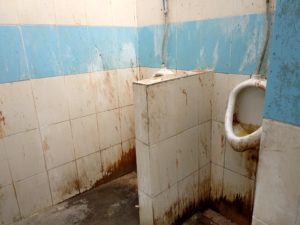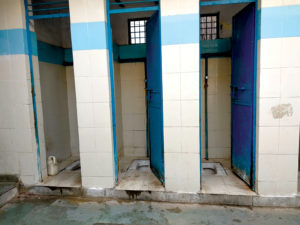Bang in the middle of the posh Panchsheel Park lies the Lal Gumbad slum, where hooligans gather to drink at night and unhygienic conditions prevail despite community toilets
With only 20 toilets for a population of 5,000, the residents of Lal Gumbad slum struggle during the day to get their turn while dealing with drunkards every single night.
Sarsati Kumari wakes up in the middle of the night because her daughter Reena, 7, has to go to the toilet. She doesn’t like asking her husband to go with Reena because that will disturb his sleep.
They cannot go to the community toilet opposite her home, for it has become a haunt for drunkards, who take over the place at night for their drinking sessions.
Stealthily, they make their way to the emergency toilet in the neighbourhood’s common toilet and washroom area. This area has separate sections for men and women and an open space for bathing. The emergency toilet is open from 10 pm to 5 am.
Worried about her daughter’s safety, Kumari makes sure she accompanies her every time she needs to relieve herself. She avoids eye contact with the drunkards while passing by. Their path is lined with hundreds of cigarette butts lying on the floor, along with plenty of empty bottles of a local liquor.
This is the horrific situation which has been developing since last year in the Lal Gumbad slum area in South Delhi. In fact, there seems to be no end to their woes, despite being situated in Panchsheel Park, with its lush greenery, wide roads, an ancient tomb and homes with chic architecture.
The area screams of the disparity between the rich and the poor. The slum is home to about 5,000 people. Its main lane is choked with bikes and carts that seem incapable of moving, and winding side lanes that are difficult to navigate.
“The whole night these men come up and sit on the bikes. Some go to the toilet area and start drinking. They occupy the entrance also. Nobody can say anything, because fights have happened in the past,” says Munni Devi, 50.
She has been living in the area for 40 years now. Although she has a makeshift bath area in the verandah of her home, she still has to use the community toilet for other purposes.
Asked about the unruly intruders, caretaker of the toilet Ranjan Kumar says, “Some of them live in this neighbourhood, while the others are their friends.” Kumar, who started handling the toilet six months ago, has also been a victim of verbal abuse.

“The poor caretaker has to bear all the verbal abuse by those drunkards. How much can he do on his own?” says Karan, 20, a resident. People living in close proximity say that those who come to drink, do not care to pick up the bottles and other trash.
Sanitation is another big issue for the residents here, so much so, that when the conversation was going on over the hygiene conditions of the toilet, a fight erupted between the residents. While most blame the shortage of caretakers for the dirty toilets, Munni Devi barges into the conversation to say that it’s the residents who must take responsibility.
“Neither the mothers or their children clean up afterwards. When they know that there’s nobody to clean these toilets, they should clean the cubicle after every use. That will solve the problem,” says Devi. She adds that every day, taps in the bathing area are covered with dirty clothes.
Almost every latrine you could see was filled with unflushed filth, with a plethora of mosquitoes, the ideal breeding ground for dengue and other vector-borne diseases.
The residents tell that cleaning workers come rarely, but the majority of the blame is put on the residents for their careless attitude over cleanliness.
Even the open men’s toilet is in a shabby state, with yellowed floors, a huge pile-up of garbage, and more liquor bottles. “This toilet is so bad that if one goes and pees there, sometimes the urine comes out of the lavatory out on the street,” says Sarsati Kumari, 58, another resident.
While the posh lanes of the Panchsheel Park do not face slightest of sanitation problems, the people of Lal Gumbad slum have been demanding sewer lines to be built.

Sanjay Kumar, pradhan of the slum, says, “We have asked the MCD. They said there will be problems for NOC. If we can have a dedicated sewer line then people can build their own toilets.”
He says that since the area has an ancient dome which is an archaeological site, the NOC is needed to use barren land for new toilets. However, Kumar argues, “You see houses (of the rich) almost 40-50 metres close to that archaeological site. They got the NOC and the land. It’s all excuses and disinterest of the authorities.”
Kumar reached out to the MLA of the area too but “no assurance was given by him.” So he reached out to MP Meenakashi Lekhi. “She has given me the assurance of getting the NOC and has promised me that double-storey toilets will be built in the area,” says Kumar.
The area currently struggles with only 20 latrines, 10 each for both the sexes. Although Kumar is relying on the promises made by Lekhi, the slum residents seem to be resigned to their fate.





